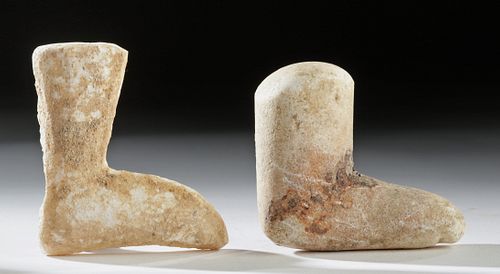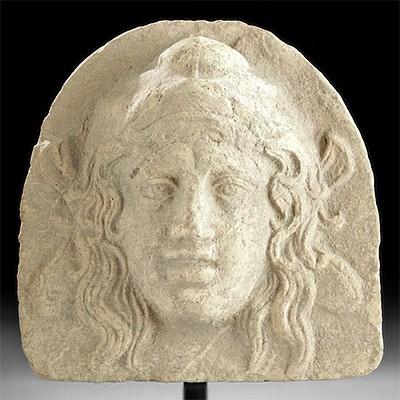Pair of Greek Cycladic Marble Limbs - Arm & Foot
Lot 21a
About Seller
Artemis Fine Arts
686 S Taylor Ave, Ste 106
Louisville, CO 80027
United States
Selling antiquities, ancient and ethnographic art online since 1993, Artemis Gallery specializes in Classical Antiquities (Egyptian, Greek, Roman, Near Eastern), Asian, Pre-Columbian, African / Tribal / Oceanographic art. Our extensive inventory includes pottery, stone, metal, wood, glass and textil...Read more
Categories
Estimate:
$2,000 - $3,000
Absentee vs Live bid
Two ways to bid:
- Leave a max absentee bid and the platform will bid on your behalf up to your maximum bid during the live auction.
- Bid live during the auction and your bids will be submitted real-time to the auctioneer.
Bid Increments
| Price | Bid Increment |
|---|---|
| $0 | $25 |
| $300 | $50 |
| $1,000 | $100 |
| $2,000 | $250 |
| $5,000 | $500 |
| $10,000 | $1,000 |
| $20,000 | $2,500 |
| $50,000 | $5,000 |
| $100,000 | $10,000 |
| $200,000 | $20,000 |
About Auction
By Artemis Fine Arts
Feb 27, 2020
Set Reminder
2020-02-27 10:00:00
2020-02-27 10:00:00
America/New_York
Bidsquare
Bidsquare : VARIETY SALE | Antiquities & Ethnographic Art
https://www.bidsquare.com/auctions/artemis-gallery/variety-sale-antiquities-ethnographic-art-4920
Around the world & back in time - be amazed at the treasures you will find. Antiquities from Egypt, Greece, Italy and the Near East, Asian, Pre-Columbian, African / Tribal / Oceanic, Native American, Spanish Colonial, Russian Icons, Fine Art, much more! Artemis Fine Arts info@artemisgallery.com
Around the world & back in time - be amazed at the treasures you will find. Antiquities from Egypt, Greece, Italy and the Near East, Asian, Pre-Columbian, African / Tribal / Oceanic, Native American, Spanish Colonial, Russian Icons, Fine Art, much more! Artemis Fine Arts info@artemisgallery.com
- Lot Description
Ancient Greece, Cycladic (final Neolithic) period, ca. 2600 to 2300 BCE. A fine set of two anthropomorphic limbs - an arm and a leg - hand-carved from chalky yellow-white marble. The smaller limb shows an arm bent at the elbow with a narrow wrist on one end and a smooth shoulder on the other. The larger limb depicts a leg with a tapering calf, a narrow ankle, and an enormous crescent-shaped foot. Size of largest (leg): 2.7" W x 3" H (6.9 cm x 7.6 cm).
Cycladic figures from this period are generally tall, thin, female figures, who are mostly found in graves, but limbs like these probably came from males - female legs and arms were almost always posed tightly together rather than separated as these are. These legs look like those from the famous "Harp Player" figures, like the one in the Metropolitan Museum of Art (47.100.1). The figures seem to have been produced for a long time, in various sizes, with abstract features. Modern artists like Picasso and Modigliani fell in love with these figures, and their simplicity makes this easy to understand. However, the pristine, abstract form that we see today does not reflect the sculptures that these ancient Greeks actually produced - they would have been brightly painted to give them features like eyes and mouths.
To see the Harp Player Figure, please see The Metropolitan Museum of Art, accession number 47.100.1: https://www.metmuseum.org/art/collection/search/254587
Provenance: private East Coast, USA collection; ex-Erika Hughes collection, New York, USA, acquired in the 1980s
All items legal to buy/sell under U.S. Statute covering cultural patrimony Code 2600, CHAPTER 14, and are guaranteed to be as described or your money back.
A Certificate of Authenticity will accompany all winning bids.
We ship worldwide and handle all shipping in-house for your convenience.
#146922Both items are fragments of larger sculptures. Each item has minor abrasions and nicks, light encrustations, and small chips. Nice earthen deposits throughout.Condition
- Shipping Info
-
All shipping is handled in-house for your convenience. Your invoice from Artemis Gallery will include shipping calculation instructions. If in doubt, please inquire BEFORE bidding for estimated shipping costs for individual items.
-
- Buyer's Premium



 EUR
EUR CAD
CAD AUD
AUD GBP
GBP MXN
MXN HKD
HKD CNY
CNY MYR
MYR SEK
SEK SGD
SGD CHF
CHF THB
THB














